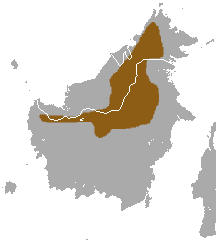Ecology and behaviour
In their natural habitat, mountain treeshrews were observed being active during the day. They forage on the ground among fallen logs and branches where they feed mostly on arthropods. They also consume large quantities of wild fruits and berries, eating them in short bursts. It is assumed that they extract sugar laden juices and in this way supplement any dietary deficiencies of an arthropod diet. [5]
Results of a behavioral study of a group of 12 wild-caught captive mountain treeshrews indicate that they are more social than groups of other treeshrew species. Two males tended to dominate the group. Females had an estrous cycle lasting nine to 12 days. Gestation lasted 49 to 51 days. They did not display a distinct reproductive season. Litters comprised one to two young. [6]
Mountain treeshrews have a mutualistic relationship with several pitcher plants species such as Nepenthes lowii , Nepenthes macrophylla , and Nepenthes rajah . They defecate into the plants' pitchers while visiting them to feed on sweet, fruity secretions from glands on the pitcher lids. [7] [8]
This page is based on this
Wikipedia article Text is available under the
CC BY-SA 4.0 license; additional terms may apply.
Images, videos and audio are available under their respective licenses.


